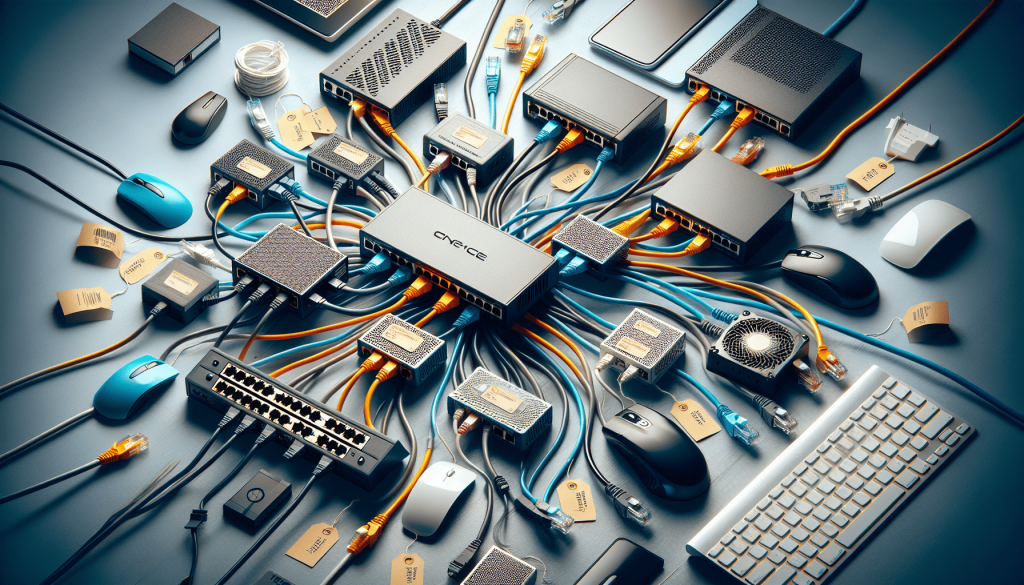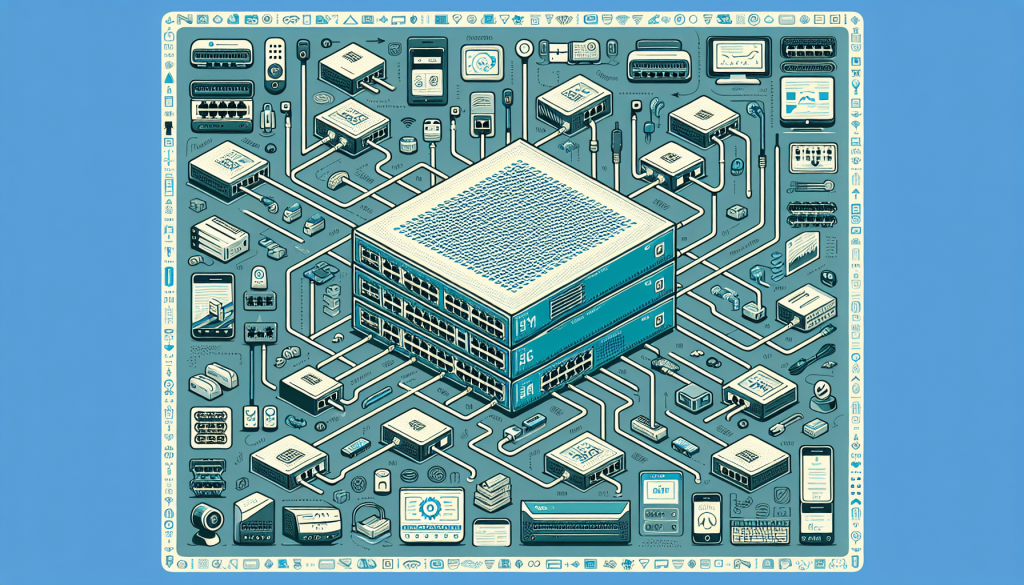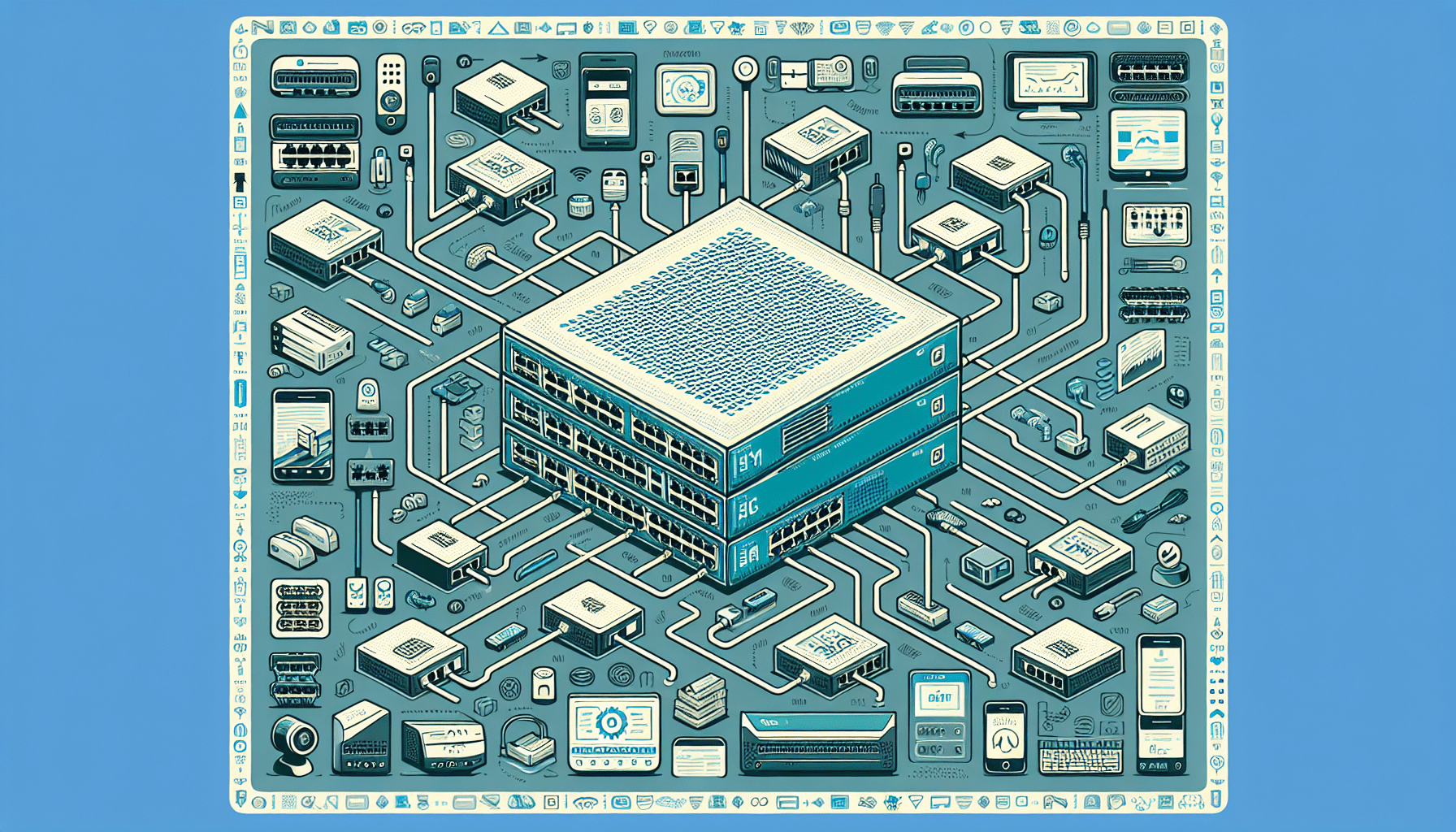So, you’ve decided to dive into the world of networking, but you’re not quite sure where to start. Don’t worry, we’ve got you covered! In this beginner’s guide, we’ll walk you through everything you need to know about buying a network switch. Whether you’re a home user looking to improve your Wi-Fi connection or a small business owner in need of a reliable network solution, this guide will provide you with all the essential information to make an informed decision. So, let’s get started and help you find the perfect network switch for your needs!

Understanding Network Switches
Definition of a Network Switch
A network switch is a device that connects multiple devices on a local area network (LAN) and enables them to communicate with each other. It acts as a central hub, directing network traffic by sending data packets to the appropriate destination device.
Importance of Network Switches
Network switches play a vital role in ensuring a smooth and efficient flow of data within a network. They provide increased bandwidth and reduce network congestion by enabling simultaneous communication between devices. With the ability to intelligently forward data packets, switches enhance network performance and improve overall productivity.
Different Types of Network Switches
There are various types of network switches available, each designed to meet different requirements. The main types include unmanaged switches, managed switches, and layer 2 vs layer 3 switches. Unmanaged switches are simple and easy to use, suitable for small networks. Managed switches offer advanced features and configuration options for larger networks. Layer 2 switches operate at the data link layer, while layer 3 switches provide routing capabilities at the network layer.
Assessing Your Network Requirements
Determining the Number of Ports Needed
To assess the number of ports needed on a network switch, you should consider the number of devices you intend to connect. Count all the devices that require an Ethernet connection, including computers, printers, and IP phones. It is advisable to have a few extra ports to accommodate future growth or unexpected additions to the network.
Identifying the Required Speed and Bandwidth
The required speed and bandwidth depend on the types of applications and activities taking place on your network. For basic internet browsing and email usage, a switch with Fast Ethernet ports (10/100Mbps) should suffice. However, if you have high-bandwidth activities such as video streaming or large file transfers, a Gigabit Ethernet switch (10/100/1000Mbps) is recommended.
Considering Future Expansion
When choosing a network switch, it is important to consider future expansion plans. Will your network grow in terms of the number of devices and users? Will there be increased data traffic? To accommodate future expansion, opt for a switch that offers scalability and has additional ports or stacking capabilities.
Evaluating Power over Ethernet (PoE) Requirements
If you have devices such as IP cameras, wireless access points, or VoIP phones that require power, consider a network switch with Power over Ethernet (PoE) capabilities. PoE eliminates the need for separate power cables and simplifies installation. Determine the power requirements of your devices to ensure the switch provides adequate PoE support.
Choosing the Right Switch Type
Unmanaged Switches
Unmanaged switches are the simplest and most cost-effective option, making them suitable for small networks or home use. They are easy to set up and operate, requiring no configuration. Unmanaged switches are plug-and-play devices that allow devices to communicate with each other without any additional features or settings.
Managed Switches
Managed switches offer more control and advanced features, making them ideal for larger networks and businesses. With managed switches, you have the flexibility to configure settings, monitor network activity, and prioritize traffic based on your requirements. They provide enhanced security, VLAN support, and options for quality of service (QoS) settings.
Layer 2 vs Layer 3 Switches
Layer 2 switches primarily operate at the data link layer (MAC addresses) of the network. They are capable of forwarding data packets within a local network segment. Layer 3 switches, on the other hand, provide routing capabilities at the network layer (IP addresses). These switches are useful for larger networks that require inter-VLAN routing or advanced routing protocols.
Understanding Switch Performance
Switching Capacity
Switching capacity refers to the amount of data that a switch can handle at any given time. It determines the maximum throughput of the switch. When choosing a switch, consider the switching capacity required to support the traffic volume of your network. Higher switching capacities are typically needed for networks with heavy data usage.
Forwarding Rate
The forwarding rate of a switch measures how quickly it can process and forward data packets. A higher forwarding rate indicates a more efficient switch that can handle higher network traffic without bottlenecks. When selecting a switch, consider the forwarding rate required to meet the demands of your network, especially if you have high-bandwidth applications or a large number of connected devices.
Buffer Size
Buffer size refers to the amount of memory a switch has to temporarily store and manage incoming and outgoing data. A larger buffer size helps prevent packet loss and ensures smooth data transmission, especially during periods of congestion. Consider the buffer size required for your network’s traffic patterns to avoid congestion-related issues.
Latency
Latency is the delay incurred when data packets travel through a network switch. Low latency is crucial for real-time applications such as VoIP or online gaming, where delays can cause disruptions or poor performance. When evaluating switches, look for low-latency switches that can provide a seamless user experience for time-sensitive applications.

Exploring Port Speeds and Standards
Fast Ethernet (10/100Mbps)
Fast Ethernet ports offer a maximum data transfer rate of 10/100Mbps, making them suitable for basic networking needs. They are commonly found in older devices and networks where high-bandwidth applications are not a priority. Fast Ethernet switches are cost-effective but may not provide the necessary speed for data-intensive activities.
Gigabit Ethernet (10/100/1000Mbps)
Gigabit Ethernet ports provide significantly faster data transfer rates of 10/100/1000Mbps. They are ideal for networks that require high bandwidth, such as file servers, video conferencing systems, or data centers. Gigabit Ethernet switches offer faster connectivity and improved performance compared to Fast Ethernet switches.
10-Gigabit Ethernet (10/100/1000/10000Mbps)
10-Gigabit Ethernet ports are designed for networks with heavy data traffic and demanding applications. They offer data transfer rates of 10/100/1000/10000Mbps, providing a substantial increase in speed compared to Gigabit Ethernet. 10-Gigabit switches are suitable for large businesses, data centers, or organizations that require ultra-fast networking capabilities.
25-Gigabit Ethernet (25/100Gbps) and Beyond
25-Gigabit Ethernet and higher speeds are emerging technologies that cater to the growing demand for increased network bandwidth. They provide faster data transfer rates, allowing for more efficient network performance. While 25-Gigabit Ethernet switches are still relatively uncommon, they are expected to become more prevalent as data-intensive applications become more widespread.
Considering PoE and PoE+ Support
Understanding Power over Ethernet (PoE)
Power over Ethernet (PoE) is a technology that allows both power and data to be transmitted over a single Ethernet cable. This eliminates the need for separate power cables for devices connected to the network switch. PoE offers convenience and flexibility when deploying network devices in areas with limited power outlets or challenging wiring scenarios.
Benefits of PoE for Network Devices
PoE can provide several benefits for network devices. It simplifies installation by reducing the number of cables needed and allows for greater flexibility in device placement. PoE also enables centralized power management, making it easier to monitor and control connected devices. Moreover, it can provide backup power during power outages, ensuring uninterrupted operation of critical network infrastructure.
Determining PoE or PoE+ Requirements
When considering PoE support, determine the power requirements of your network devices. Simple devices like IP phones or security cameras may only need standard PoE (15.4W per port), while more power-hungry devices such as wireless access points or pan-tilt-zoom (PTZ) cameras may require PoE+ (30W per port) or higher. Ensure that the switch you choose can deliver the necessary power output to support your devices.
Evaluating Switch Management Features
Configurability and Flexibility
Managed switches offer greater configurability and flexibility compared to unmanaged switches. They allow for customization of network settings, such as VLANs, link aggregation, and port mirroring. With a managed switch, you’ll have more control over your network infrastructure and the ability to optimize performance and security.
VLAN Support
Virtual Local Area Networks (VLANs) are used to segregate network traffic, improving security and network efficiency. Managed switches provide VLAN support, allowing you to create and manage multiple VLANs on a single physical switch. This helps control broadcast traffic and provides increased security by isolating devices within specific VLANs.
Quality of Service (QoS) Features
Quality of Service (QoS) allows you to prioritize certain types of network traffic over others. Managed switches offer QoS features that enable you to assign different priorities to data packets, ensuring that critical applications receive the necessary bandwidth and minimizing network congestion.
Security and Access Control
Managed switches offer enhanced security features, including access control lists (ACLs), port security, and secure management options. ACLs allow you to control which devices have access to specific network resources, while port security ensures that unauthorized devices cannot connect to the network. Secure management options, such as SSL/TLS encryption, protect sensitive network information.
Network Monitoring and Traffic Analysis
Managed switches provide robust network monitoring and traffic analysis capabilities. They offer features such as port mirroring, which allows you to monitor specific traffic flows, and SNMP (Simple Network Management Protocol) support for remote monitoring and management. These features enable you to troubleshoot network issues and optimize performance.
Considering Switch Reliability and Redundancy
Redundant Power Supplies
Redundant power supplies ensure that a switch remains operational even if one power supply fails. This feature is critical for networks that require high availability and minimal downtime. Switches with redundant power supplies automatically switch to the backup power supply in the event of a failure, providing a reliable and uninterrupted power source.
Hot Swappable Fans
Hot swappable fans allow for easy replacement of faulty or worn-out fans without interrupting the switch’s operation. With hot swappable fans, you don’t need to power down the switch or disrupt network connectivity when replacing a fan. This feature ensures that cooling is maintained and extends the lifespan of the switch.
Link Aggregation (LAG) for High Availability
Link aggregation, also known as link bonding or port trunking, is a technique that combines multiple physical links into a single logical link. This improves network performance and redundancy by increasing bandwidth and providing failover capability if one link fails. LAG enables high availability and ensures uninterrupted network connectivity.
Spanning Tree Protocol (STP)
Spanning Tree Protocol (STP) is a network protocol that prevents loops in Ethernet networks. It allows switches to dynamically discover the best paths and automatically block redundant connections to avoid network loops. STP ensures network stability and resilience by preventing broadcast storms and ensuring efficient packet transportation.
Taking Cost and Budget into Account
Comparison of Switch Price Ranges
Network switches vary in price, depending on their features and capabilities. Unmanaged switches are generally more affordable, making them suitable for budget-conscious individuals or small networks. Managed switches with advanced features usually come at a higher price point. It is essential to consider your budget and weigh the features against the cost to find the best switch for your needs.
Balancing Features and Cost
When choosing a network switch, it is important to strike a balance between the desired features and the available budget. Determine which features are essential for your network requirements and prioritize them accordingly. Consider the long-term value of the switch, including its scalability, reliability, and support, to ensure that you are investing in a cost-effective solution.
Considering Long-term Value
The long-term value of a network switch goes beyond its initial cost. Consider factors such as the switch’s lifespan, scalability, and compatibility with future technologies. A switch that can adapt to evolving network requirements and provide reliable performance over an extended period will offer better long-term value and ensure the stability of your network.
Researching and Comparing Switch Brands
Reputable Network Switch Manufacturers
There are several reputable network switch manufacturers that offer reliable and high-quality products. Some well-known brands include Cisco, Juniper Networks, HPE Aruba, Dell EMC, and NETGEAR. Research these manufacturers and others to determine which brand aligns with your network requirements and offers the best combination of features, performance, and support.
Reading Product Reviews and Ratings
Before making a final decision, it is advisable to read product reviews and ratings from reputable sources. These reviews provide insights into the performance, reliability, and user experiences of specific switch models. They can help you identify any potential issues or limitations and make an informed decision based on real-world feedback.
Considering Warranty and Support
When purchasing a network switch, consider the warranty and support offered by the manufacturer. A comprehensive warranty ensures that you can rely on the switch for a specified period without incurring additional costs. Additionally, excellent customer support is crucial for timely assistance and troubleshooting. Consider the reputation of the manufacturer’s support services before making your final decision.
In conclusion, understanding the various aspects of network switches is essential when looking to buy one. Consider your network requirements, such as the number of ports needed, required speed and bandwidth, and potential future expansion. Evaluate the different types of switches, such as unmanaged and managed switches, and understand the performance factors like switching capacity, forwarding rate, buffer size, and latency. It is also important to consider port speeds and standards, such as Fast Ethernet, Gigabit Ethernet, and 10-Gigabit Ethernet. Furthermore, determine the need for Power over Ethernet (PoE) and PoE+ support, and evaluate switch management features like configurability, VLAN support, QoS features, security, and network monitoring. Reliability and redundancy features, cost considerations, and researching and comparing switch brands are also important aspects to consider. By thoroughly understanding these factors, you can make an informed decision and choose the right network switch for your requirements.
